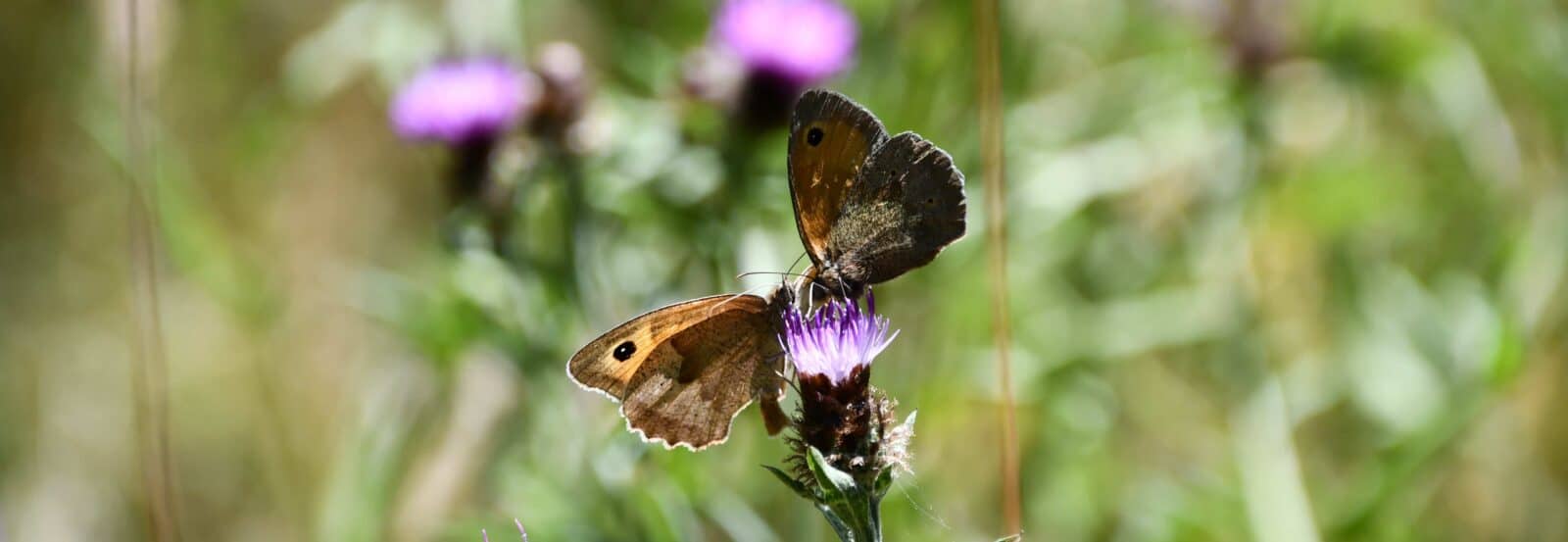Happy Insect Week – the week where we celebrate the little things that help run the world!
For this week-long event, learn why and how we’re supporting insects, and download some free useful resources that will help you with insect identification and recording.
What is Insect Week?
Insect Week is an initiative run by the Royal Entomological Society (RES), which serves as an opportunity to appreciate and learn more about these often overlooked creatures. As part of this week-long celebration (19th June – 26th June), RES and other organisation across the UK support the project by enabling people to get involved in activities and learning opportunities that are all tailored around insects.
Visit the Insect Week website.
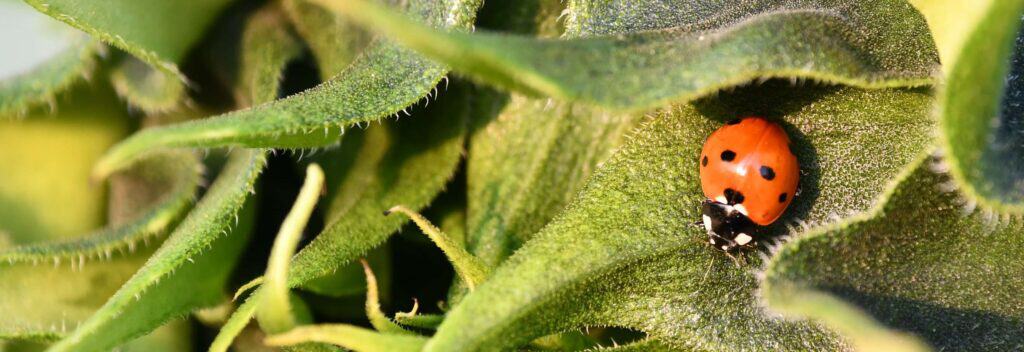
Why the Field Studies Council are getting involved
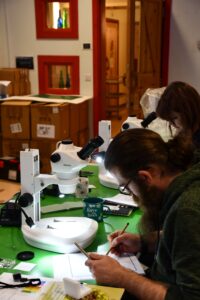
You may have seen reports, research articles and news features about the threats insects are facing, and the 2019 State of Nature Report highlighted how we have seen declines in the UK. These declines have far-reaching consequences for ecosystems, as insects provide essential services such as pollination and nutrient recycling.
With 80 years of experience, the Field Studies Council have championed insects over the years through research projects, the development of insect identification guides and educating others through courses led by experts – and we want to continue doing so! Plus, we have also been part of a long series of projects that have focussed on increasing invertebrate identification skills across the UK, and the most recent of those was the BioLinks project…
The BioLinks project
Over the past five years, the BioLinks project has been boosting biodiversity skills and expanding the UK’s database of underappreciated invertebrate species. Funded by the Field Studies Council and the National Lottery Heritage Fund, this project held 490 in-person events, teaching people how to identify invertebrates – including a vast diversity of insect groups. BioLinks successfully equipped over 5,000 participants with the knowledge and tools to identify a diverse range of species, including flies, beetles, bees, and butterflies.
By providing comprehensive training on identification techniques, BioLinks has empowered countless individuals to delve into the fascinating world of invertebrates. Not only did the project enlighten learners, but it also encouraged them to submit biological records based on their newfound expertise. As a result, an impressive 35,000 invertebrate records have been generated!
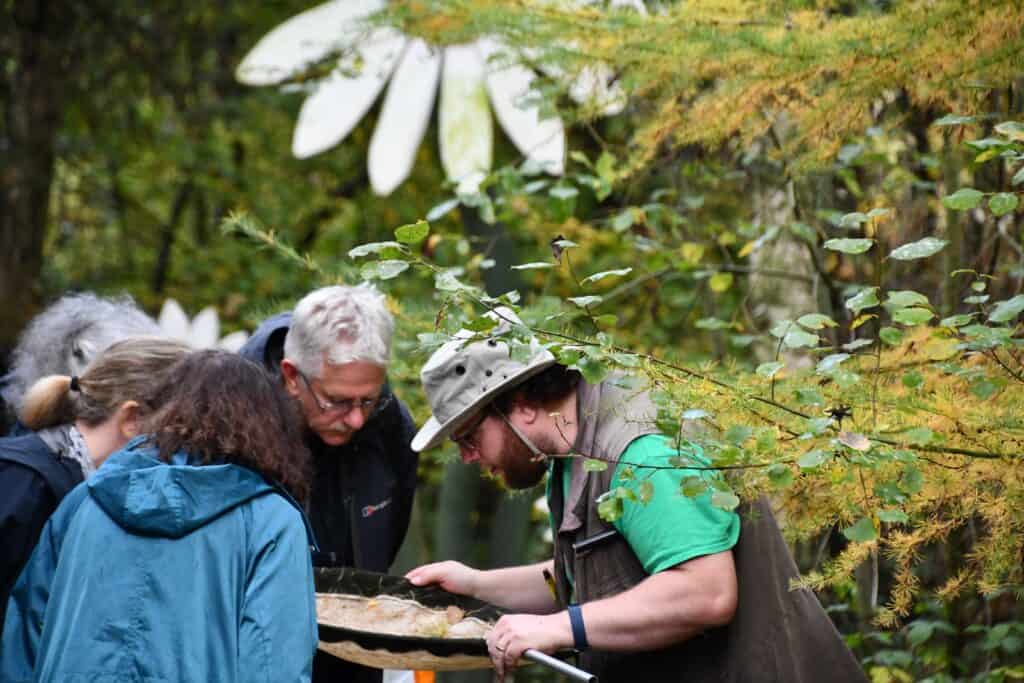
Working together to increase insect knowledge
To increase the promotion and awareness of insect recording, the Royal Entomology Society awarded the Goodman Award Grant to the BioLinks project. This grant facilitated the creation of accessible insect morphology infographics, that will help learners who are new to the topic.
BioLinks created ten infographics and an educational video, helping to advance the public’s understanding of insects. By introducing scientific terminology in a visually engaging manner, these resources act as a stepping stone for individuals who want to use insect identification keys. Plus, these valuable resources are accessible under a creative commons license, allowing learners to utilize them as indispensable reference materials, while also enabling other organisations to incorporate them into teaching resources.
You can download all the infographics at the bottom of this blog.
An introduction to insect morphology
So, what makes an insect an insect?
Before we delve further into the characteristics of specific insect orders, you need to know what an insect is, so here are the key features they possess:
- One pair of compound eyes
- Three pairs of jointed legs
- One pair of antennae
- A body comprised of three sections – the head, thorax, and abdomen.
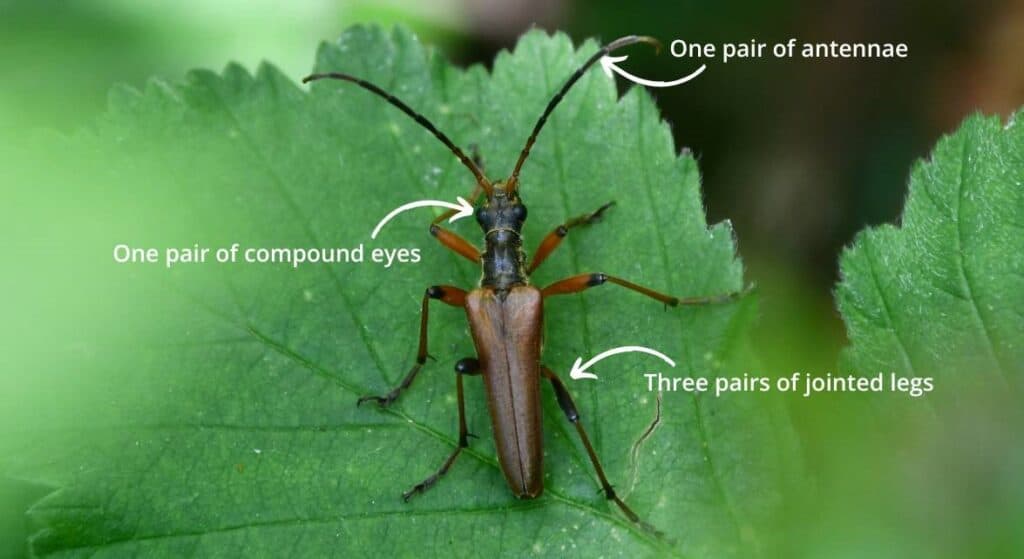
Once you’ve determined that something is an insect, you can go on to identify which group (order) it belongs to. Here are some visual introductions to common insect orders that can be found in the UK.
Beetles
Order: Coleoptera
A key feature of beetles is their hardened wing cases known as elytra. Typically, beetles have two pairs of wings; however, their forewings have become hardened. This feature gives beetles their scientific name ‘Coleoptera’, meaning ‘sheath winged’.
Other key features of this group include: membranous hindwings, chewing mouthparts, and usually one pair of compound eyes.
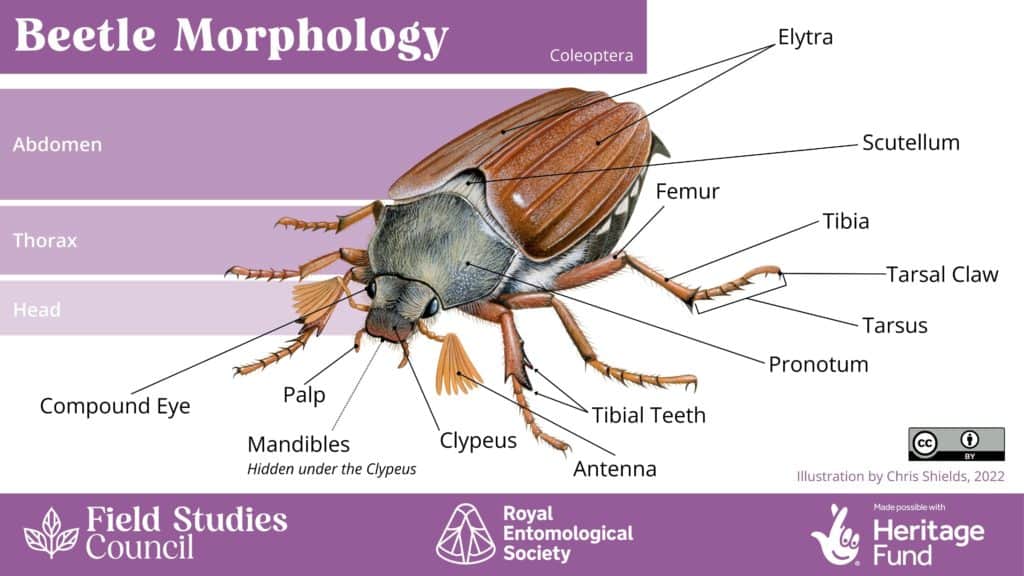
Join us in Worcestershire on the 15th of July to learn more about Ladybirds – a great insect group to start your identification journey – sign up.
You can learn more about beetle morphology in our YouTube video. Subscribe to our channel to get notifications of any new content.
True Bugs
Order: Hemiptera
These small to large insects are found in multiple habitats, and they can vary greatly in shape, size, and colour. The order Hemiptera is broken down into multiple suborders, but this infographic depicts one of the most familiar and commonly encountered suborders (Heteroptera), which includes shield bugs, plant bugs, and forest bugs. But one thing that all Hemiptera have in common is their long feeding tube known as the ‘rostrum’, which allows them to pierce their food source and extract liquid from within it.
Their wings are also unique, as they do not meet at the midline of the abdomen when at rest. Additionally, the forewings have a partially thickened base, and the rest of the forewing is membranous – it is this feature that gives them their name, ‘Hemiptera’, which means ‘half-wing’.
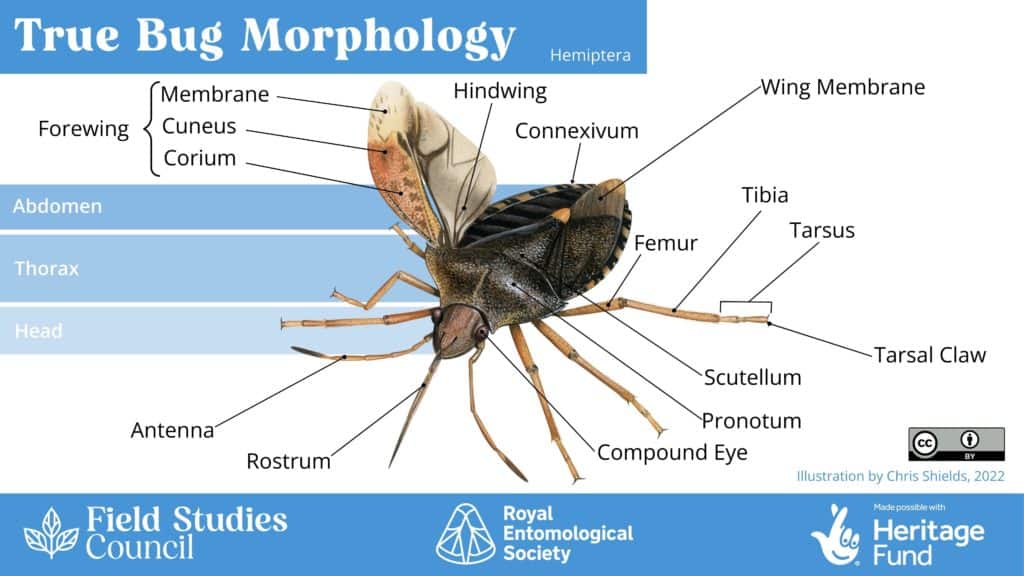
Flies
Order: Diptera
This group are the aerial acrobats of the insect world! Flies appear to have only a single pair of wings, as the hind wings have evolved into stabilising organs known as ‘halteres’. Halteres are small peg-like structures extending from their thorax. They can be tricky to spot in some species, but they can be easily seen on a cranefly.
There are other characteristics that make flies stand out, including a large moveable head, very large compound eyes, and sucking or piercing mouthparts.
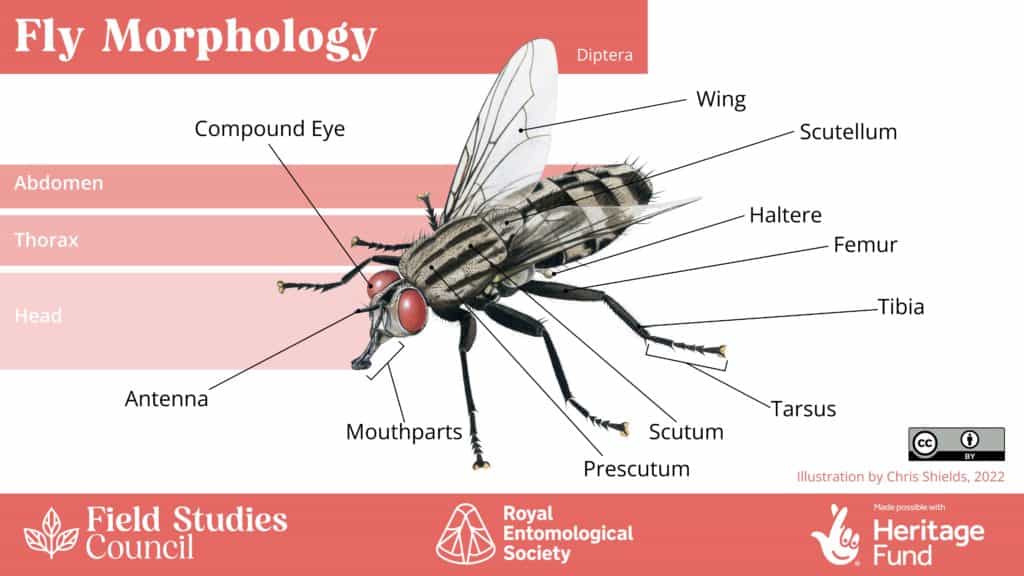
Caddisflies
Order: Trichoptera
Caddisflies spend most of their life in water as larvae, and they are often used as indicator species for water quality reports.
Adult caddisflies have elongated bodies, although two pairs of membranous wings often hide this. When resting, their wings are held in a tent-like formation over the abdomen (the diagram below illustrates how their wings may look resting or extended). Their wings are also covered in fine hairs and lack scales (unlike butterflies and moth wings). They also have long thread-like antennae used for sensing chemical cues (how insects interpret environmental stimuli and signals from other individuals).
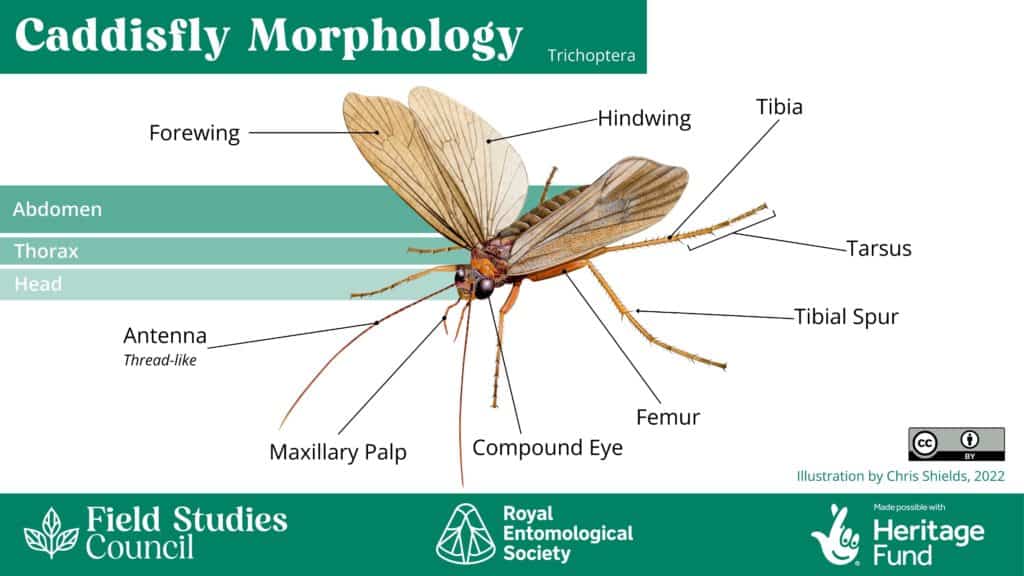
Mayflies
Order: Ephemeroptera
The typical ‘sailboat’ wing pose of a mayfly.
Mayflies are considered some of the most primitive living examples of winged insects. As adults, they have two pairs of wings. The larger, sail-shaped forewings are held vertically above the abdomen when at rest, alongside the smaller hindwings. This resting position gives them a signature ‘sailboat’ pose (our diagram illustrates their wings spread flat to show the difference in size between the forewings and hindwings).
The head of a mayfly consists of large compound eyes and very short mandibles. They have a ‘chunky’ thorax with a long-tapered abdomen attached. You can find obvious ‘tails’ at the end of the abdomen, also referred to as cerci. The number of cerci will vary with each species, but it is common for three to be present.
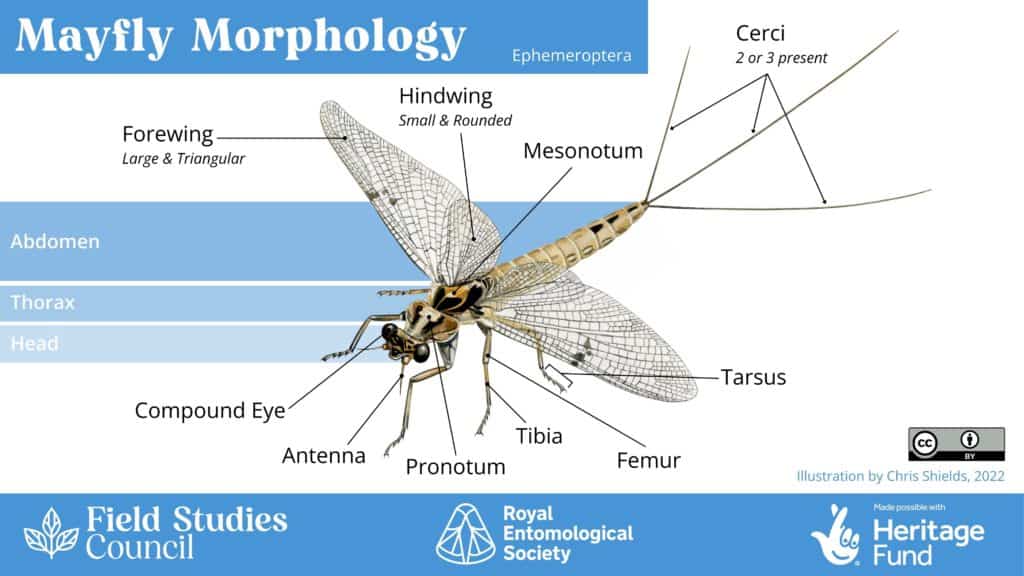
Stoneflies
Order: Plecoptera
Stoneflies are similar to caddisflies in a way that they are also considered one of the most primitive groups of flying insects. The name ‘Plecoptera’ translates to ‘braided wing’, which refers to the characteristic shape of the wing cells that result in a ladder-like pattern. Although they have two pairs of wings, they are rather poor fliers. Their wings lie flat against the top of their abdomen when resting.Other key features include their long thread-like antennae, small beady compound eyes, and a pair of cerci at the end of their abdomen.
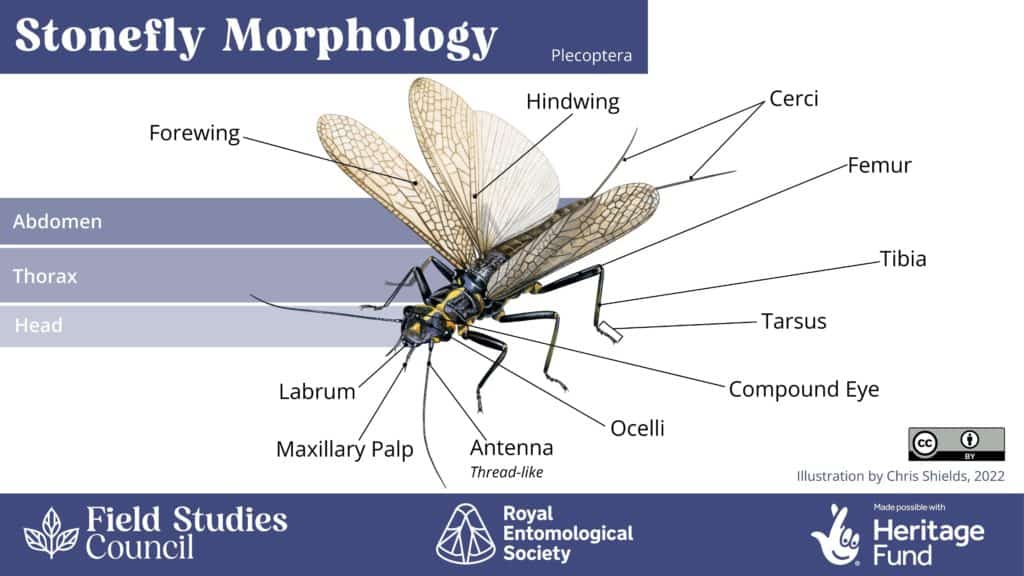
Dragonflies and Damselflies
Order: Odonata
The taxonomic group Odonata contains both dragonflies and damselflies. Our infographic below depicts a typical dragonfly; however, dragonflies and damselflies possess similar body structures and features.
One of the most noticeable features is their long, thin abdomen. They also have two pairs of long wings, which are all similar in size. On their forewings, they have a ‘pterostigma’, a dark blotch along the main vein of the forewing – a feature often used in species identification.
Other key features of the group include their large mobile heads with large compound eyes. This combination of features makes them impressive predators, able to navigate and catch prey at speed.
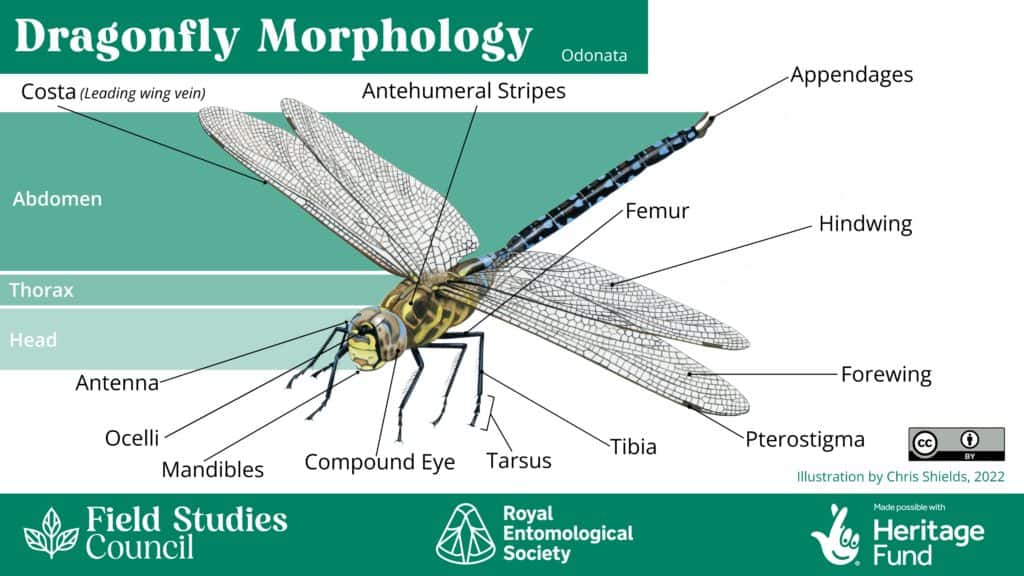
Bees, Wasps, and Ants
Order: Hymenoptera – this group contains bees, wasps, ants, and sawflies.
We have illustrated the bees, wasps, and ants, and for all three, you can see one common feature – a narrowed waist, sometimes referred to as the petiole.
Bees
As mentioned, bees will have a constricted waist, although this may be hard to see in bumblebees and species covered by dense hairs. Hairs are used to keep the bee warm and collect pollen. Some bees will also have a ‘corbicula’ on their hind leg (their ‘pollen basket’), which is used to collect and transport pollen.
All adult bees have two pairs of wings, with larger forewings and smaller hindwings.
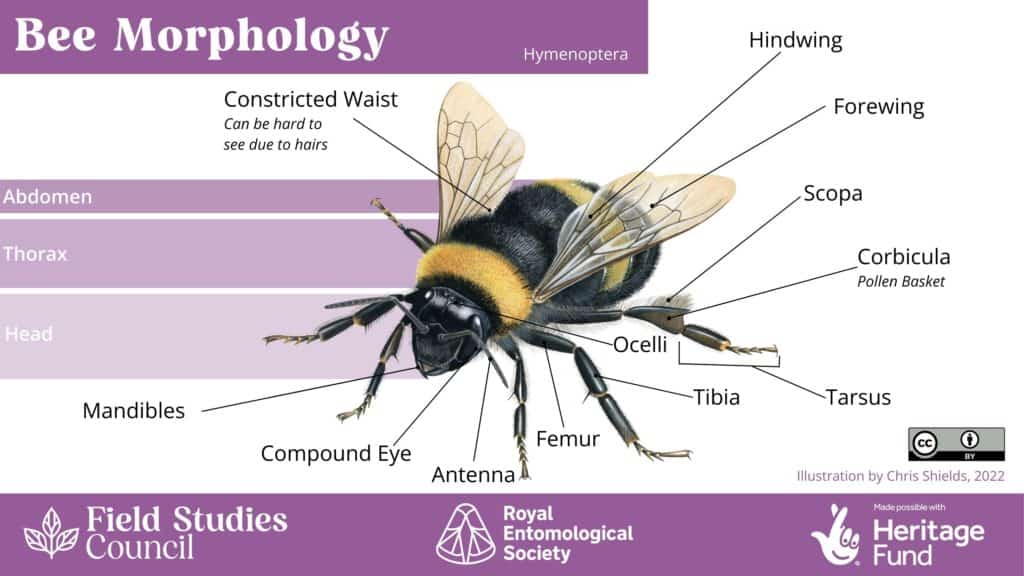
Wasps
Wasps usually have an obvious constricted waist, a smooth body with relatively few hairs, and two pairs of wings. They may also possess a sting at the end of their abdomen, which can subdue prey or defend against predators.
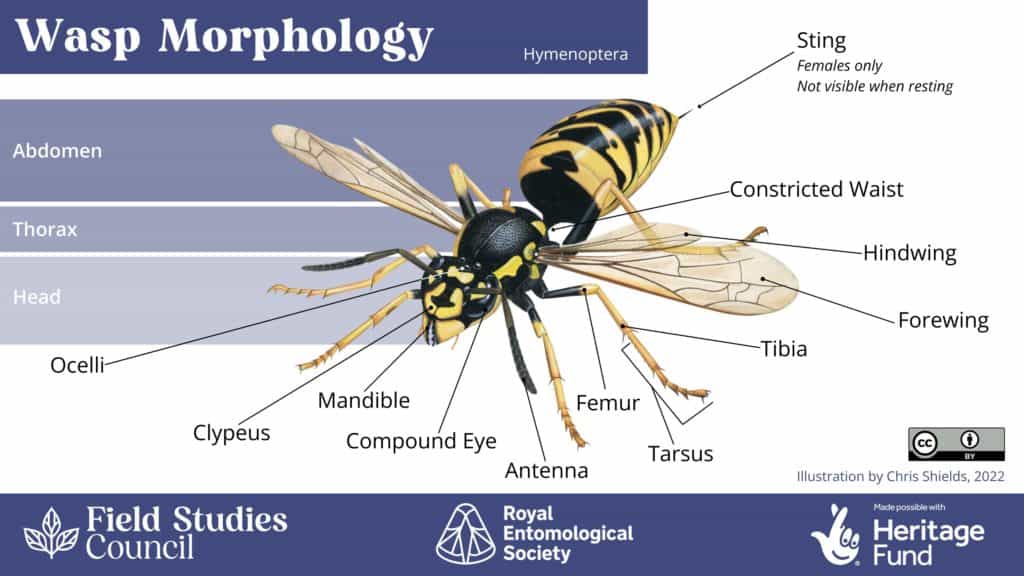
Ants
Ants have the most striking differences when comparing them to bees and wasps. However, ants also vary in form between queens, workers, and males (these are referred to as castes). One key morphological difference between the castes will be the presence or absence of wings, which can also vary with different species.
It’s also worth noting that ants do not entirely conform to the standard insect body plan. Instead, their body sections are more commonly referred to as the head, mesosoma (comprised of the pronotum, mesonotum, and propodeum), petiole, and gaster.
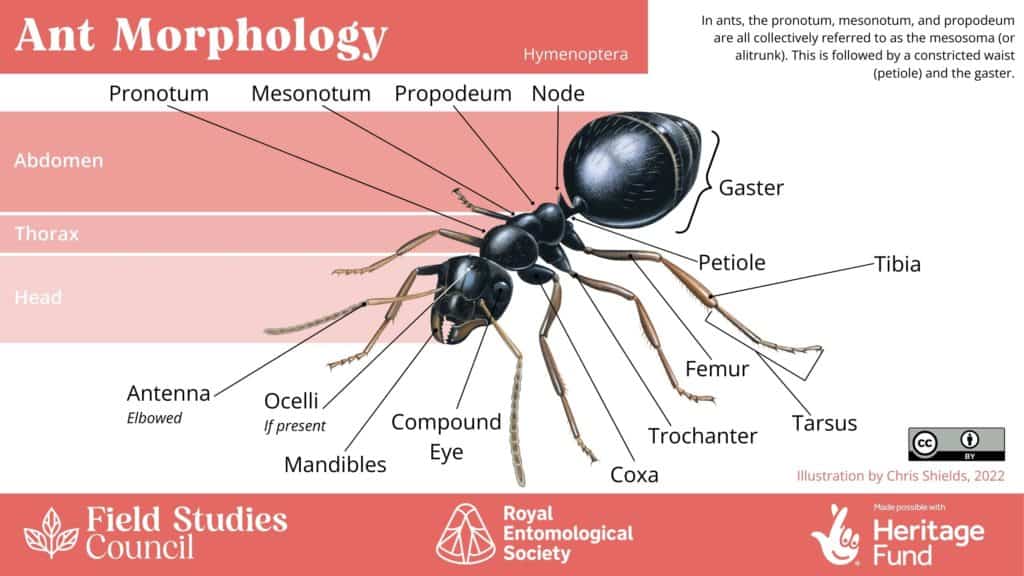
Download the Insect Morphology Infographics
Creating biological records
Once you’ve got to grips with distinguishing different groups of insects, you can go on to learn how to identify individual species. You can even add your sightings to databases (like iRecord) that help inform conservation practices and track the distribution and health of wildlife in the UK – it’s such a fantastic way for anyone to contribute to helping wildlife conservation!
Learn how to use iRecord to submit your sightings
To help you get started with insect identification and recording your sightings (biological recording), you can download and refer to these Guidance Notes – more fantastic resources created by the BioLinks Project!
Field Studies Guidance Note: Introduction to Taxonomy – This guidance note defines taxonomy, presents its history, and explains taxonomic ranks, groups of relatedness and the naming of organisms.
Field Studies Guidance Note: Invertebrates Under the Microscope – Information about how to identify invertebrates using a microscope. Details and tips are given to help you choose which type of microscope is best and how to use them.
Field Studies Guidance Note: Biological Recording – This guide explains what a biological record is, how to improve the data resolution and data quality of a biological record, the process of submission, validation and verification of a biological record, and the different uses and purposes of biological recording.
Field Studies Guidance Note: Grid References for Biological Recording – This guide discusses the importance of grid references, plus finding, reading and accuracy, particularly in relation to biological recording.
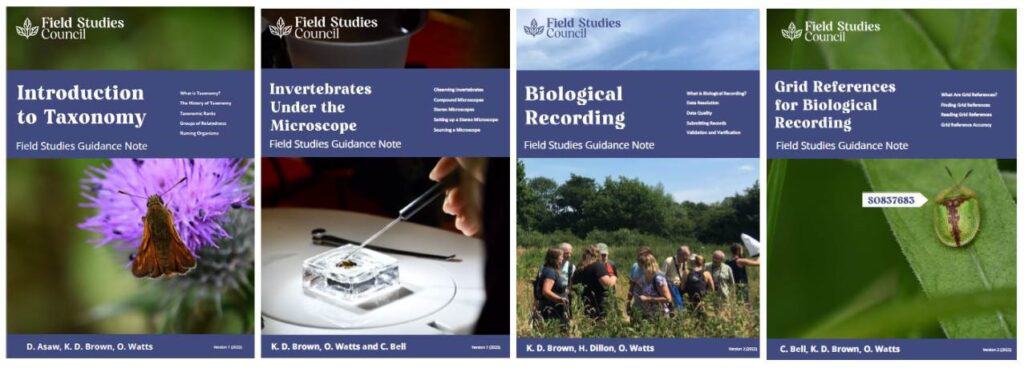
Further your learning
In addition to all these handy free resources, we have a vast range of biodiversity courses that delve into a multitude of subjects – including insects! Courses are located across Britain in some beautiful locations. We also have plenty of online courses helping you to upskill from home.
Plus, we have a variety of guides that can help beginners or experts with insect identification. Browse our online shop.


